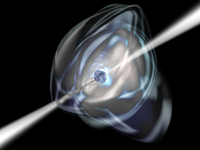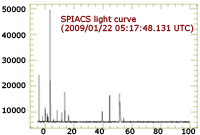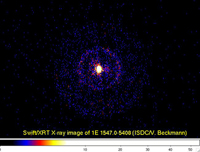Magnetar observed during outburst thanks to rapid response of INTEGRAL
27 January 2009
The quick turn-around time of the INTEGRAL operation teams has enabled rare high-energy observations of a magnetar. The observations, which were performed as a Target of Opportunity, followed indications late last week that this magnetar, the Anomalous X-ray Pulsar, 1E 1547.0-5408, had entered outburst mode.
 |
|
Artist's impression of an AXP. Credit: ESA |
1E1547.0-5408 is one of only 9 confirmed Anomalous X-ray Pulsars (AXP) - isolated, young neutron stars with unusually strong magnetic fields (1014G -1015G). Together with Soft Gamma Repeaters they make up a class of celestial object known as magnetars.
Magnetar active state triggers alerts on several satellites, including INTEGRAL
The first sign that this magnetar had entered a new active burst state came early on Thursday 22 January when the Swift Burst Alert Telescope (GCN 8833) and the Fermi Gamma-Ray Burst Monitor (GCN 8835) recorded a number of hard X-ray triggers which were identified as originating from the direction of 1E 1547.0-5408.
 |
|
15 of the 200 outburst detected by the INTEGRAL ACS on 22 January 2009. Credit: ESA |
Exceptional activity results in public Target of Opportunity
Recognising that this was a rare opportunity to observe close to, and possibly during, an outburst state, Beckmann and other scientists submitted Target of Opportunity requests for immediate observations of this object to the INTEGRAL Science Operations Team. These were received on 22 and 23 January. After careful consideration the ToO was granted by the INTEGRAL Project Scientist, Christoph Winkler, and a 100,000 second observation planned and executed. This ToO began at 15:30:59 on 24 January and continued until the end of the visibility window at 22:14:36 on 25 January.
Given the interest expressed by the scientific community in these observations the Project Scientist declared the ToO to be public and all scientific data recorded during this ToO has now been made publicly available from the INTEGRAL Science Data Centre at Geneva. (See the link to ToO data for 1E 1547.0-5408 on the right-hand menu.)
Early results: magnetar still active, spectrum measured
A preliminary examination of the data indicates that the magnetar was still in an active phase during the ToO and that it was detected by all X-ray instruments on-board the satellite. Apart from bursts, which occurred during the observation and were again seen by several satellites, it was also possible to determine the X-ray spectrum of this AXP. The spectrum extends up to energies of at least 150 keV and has the signature of processes usually associated with emission of a jet or other non-thermal processes, rather than showing a "hot spot" on the neutron star’s surface (ATEL 1908).
 |
|
Ring-like halos are seen in Swift images. |
A simultaneous observation of lower energy X-rays by the Swift satellite indicates that the X-ray emission is travelling towards us through dusty regions of our Galaxy causing ring-like halos in the X-ray images (GCN 8848). This allows scientists now not only to study the neutron star itself, but also the interstellar medium of the Milky Way.
Further observations of 1E 1547.0-5408 with INTEGRAL are planned for later this week as part of an additional dedicated observation.
Contacts:
Volker Beckmann, Operations Coordinator, INTEGRAL Science Data Centre
Volker.Beckmann unige.ch
unige.ch
Christoph Winkler, ESA Integral Project Scientist
christoph.winkler esa.int
esa.int

